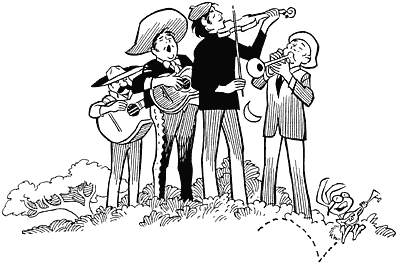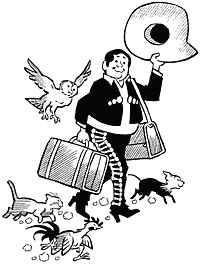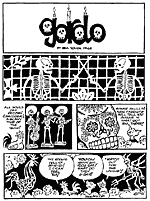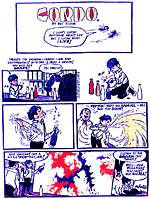History
of
Pioneering American Comic Strip
about Mexican Milieu
Rehearsed in Harvey’s
Latest
Book |
A
HIGHLY REGARDED BUT LESSER-KNOWN MASTERPIECE of cartooning at last achieves
some of the visibility it deserves in the latest work by Robert C. Harvey,
a noted critic-historian of the medium. In Accidental Ambassador Gordo:
The Comic Strip Art of Gus Arriola, Harvey provides both a biography
of the cartoonist and a generous sampling of Gordo from the 44-year
run of the comic strip that many regard as a triumph of design in cartooning.
According to Jud Hurd, who, for thirty years, has edited and published
a quarterly journal about the cartooning profession, Cartoonist PROfiles,
Arriola is enthusiastically envied by everyone in the inky- fingered fraternity.
“He is one of the few cartoonists whose work other cartoonists drool over,”
Hurd once said.
Mort Walker agreed: “Gordo was an exceptional strip
visually,” said the creator of Beetle Bailey, Hi and Lois, and
several other comic strips. “I was really charmed by his drawing,” he
went on. “And his Sunday page was a work of art. He seemed to indulge
himself in creating new visual techniques to charm the eye. It was just
a lot of fun to look at. I found myself not even reading it as much as
enjoying the pictures. He is a superb artist.”
Said Charles Schulz of Peanuts fame: “My admiration for the drawing
that Gus puts into Gordo knows no bounds. Gus can draw anything.
Better than that, Gus can cartoon anything, and there is a world of difference.”
For virtually all of the strip’s 1941-1985 run, Arriola (born
in 1917 in Arizona) was the most visible American of Mexican descent working
as a syndicated comic strip cartoonist, and Gordo was the more
widely circulated (270 papers at its peak) and the longer-running of only
two comic strips with a Mexican milieu. (The other was Little
Pedro by William de la Torre, which ran c. 1948-1974. It
was offered by a small syndicate and never had very great circulation.)
Published by the University Press of Mississippi, Accidental Ambassador
rehearses the history of the strip--and the remarkable evolution of its
creator’s artistic talent and social conscience.
In the beginning, Gordo retailed the humorous adventures and amorous
preoccupations of a portly Mexican bean farmer (“gordo” means “fat”),
his perspicacious nephew, the menagerie of their farm animals, and the
other citizens of their village. More by accident than
by deliberate intention, Gordo evolved an ambassadorial function, representing
life in Mexico to its American audience.
At first, Arriola’s depiction of his characters perpetuated the stereotypical
imagery of Mexicans found in Hollywood and American popular culture. Eventually,
however, as Arriola realized his comic strip was one of the few mass circulation
vehicles in the United States that portrayed Mexicans, he began in the
1950s to take pains to reflect accurately the culture south of the border. Converting
his protagonist to a tour guide in the 1960s, Arriola was able to regale
American readers with many aspects of Mexican folklore, history, and art
in an entertaining (but informative) fashion, winning awards and accolades
for his efforts. The National Cartoonists Society named Gordo
the best humor comic strip in 1957 and again in 1965.
click above images to enlarge
Because the animal (and, later, insect) characters in the strip had always
been one of its chief attractions, Arriola was creatively positioned to
stump for ecological concerns, and he was one of the earliest figures
in popular culture to do so.
But Gordo was more than an ethnic goodwill emissary. The comic
strip was profoundly about people and humanity, as San Francisco Chronicle
columnist Herb Caen recognized:
 |
“We all
need families, our own and at least one other,” he once wrote. “For
more years than I care to think about, my other family has been
the singular creation of Gus Arriola—Senor Gordo and his extended
menagerie of diverting humans and spectacular animals. Haven't we
all wanted to live as Gordo does? One can only envy him his charmed
life: the perfect village, the adorable senoritas, the easily survivable
hangovers and heartbreaks, and the marvelous array of animals that
give the comic strip—a term that seems inadequate—its several dimensions.
. .
“Gus's are real people,” Caen continued, “the kind one can easily
and happily live with for a quarter of a century. I know, because
I have done it. As for Gordo himself, he is a literary contrivance
of the first magnitude—buffoon as hero, great lover manque, a pen-and-ink
Everyman whose triumphs and tragedies are our own. Long may he and
his flock survive. Breakfast without them would be unthinkable.”
|
Arriola matched his literary achievement with graphic wizardry. He
was a supremely inventive stylist, and his artwork always displayed design
qualities unusual for a comic strip. Harvey traces Arriola’s
artistic evolution with many examples, including an eight-page color section
that samples Arriola’s Sunday strips in which the cartoonist exploited
the medium to produce stunning fiestas of color and design.
click above images to enlarge
Hank Ketcham, creator of Dennis the Menace and a stylistic virtuoso
himself, said this of his friend: “Gus is a terrific draftsman—and designer.
His design was just so crisp and nice, and the color on Sunday was great.
Today they've squeezed the Sunday size down to the nub, and it would
be a shame to do that to his stuff.”
Magazine and Mad cartoonist Paul Coker Jr.—another outstanding
stylist—noted: “It's remarkable that without much art training, Arriola
managed to make the strip far superior from the design and drawing standpoint
to almost anything else in the papers.”
Eldon Dedini, whose spectacular watercolor cartoons have decorated Playboy
magazine for decades, is a longtime friend of Arriola’s and admires
his work: “He's more of an artist than 99 percent of the cartoonists.
And the Sunday color was tremendous. He would make the color designations
for the engravers; I don't think all cartoonists are that involved in
selecting the color for their strips. For them, skies are blue, grass
is green. But Gus would make red skies. The whole thing was designed,
probably with a Mexican feeling.”
Reflecting on the extracomedic content of the strip, Dedini went on:
“Ecology and race relations were Gus's concerns long before they appeared
in other strips.” He paused. “And he made cartooning look so easy,”
he continued. “All by himself. He did it all by himself. No assistants,
no gag men (except Frances, his wife). What you saw in Gordo
was all Gus. He brought a sensitivity and insight to his cartoons that
existed in no other strip. Unique. People knew it and felt it. And they
honored him for it.”
Harvey, a minor league cartoonist himself, has been a fan of Gordo
since his youth in the 1950s. “Doing this book gave me the
opportunity to read again many of my favorite stories from the strip,”
he said. “As a youth studying the strip and imitating Gus’s
drawing style, I loved these stories. As often happens when
you revisit scenes from your past, none of them seem quite the same
now. All of them are better than I remembered them. They’re
full of nuances both narrative and pictorial so finely wrought that
they slipped by my youthful perceptions wholly unnoticed.”
Arriola told humorous stories in the strip until sometime in the late
1950s, when he began doing free-standing gags every day for long stretches. But
he would pick up the thread of continuity every once in a while, returning
to storytelling for several weeks at a time.
As a result, Gordo has not only a personality but a personal history,
and the book rehearses much of it by rerunning several of the stories
and excerpting from key continuities. Gordo’s frequent encounters
with the voracious Widow Gonzalez, for instance (the only female of
the species he ran from rather than towards) are outlined and sampled.
Accidental Ambassador Gordo runs 256 pages, $30 in paperback;
well over half the book is devoted to reprinting of strips. Available
from Harvey with a specially designed bookplate signed by both Harvey
and Arriola. To order, click here.
|





